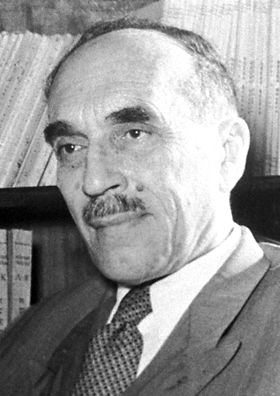
Pavel Samuilovich Urysohn was a Soviet mathematician who is best known for his contributions in dimension theory, and for developing Urysohn's metrization theorem and Urysohn's lemma, both of which are fundamental results in topology. His name is also commemorated in the terms Urysohn universal space, Fréchet–Urysohn space, Menger–Urysohn dimension and Urysohn integral equation. He and Pavel Alexandrov formulated the modern definition of compactness in 1923.

Andrey Nikolaevich Kolmogorov was a Soviet mathematician who contributed to the mathematics of probability theory, topology, intuitionistic logic, turbulence, classical mechanics, algorithmic information theory and computational complexity.

Leonid Anatolievich Levin is a Soviet-American mathematician and computer scientist.

Nikolay Nikolayevich Semyonov , sometimes Semenov, Semionov or Semenoff was a Soviet physicist and chemist. Semyonov was awarded the 1956 Nobel Prize in Chemistry for his work on the mechanism of chemical transformation.

Nikolai Nikolayevich Luzin was a Soviet and Russian mathematician known for his work in descriptive set theory and aspects of mathematical analysis with strong connections to point-set topology. He was the eponym of Luzitania, a loose group of young Moscow mathematicians of the first half of the 1920s. They adopted his set-theoretic orientation, and went on to apply it in other areas of mathematics.
Boris Vladimirovich Gnedenko was a Soviet mathematician and a student of Andrey Kolmogorov. He was born in Simbirsk, Russia, and died in Moscow. He is perhaps best known for his work with Kolmogorov, and his contributions to the study of probability theory, particularly extreme value theory, with such results as the Fisher–Tippett–Gnedenko theorem. Gnedenko was appointed as Head of the Physics, Mathematics and Chemistry Section of the Ukrainian Academy of Sciences in 1949, and became Director of the NASU Institute of Mathematics in 1955.
Sergei Ivanovich Adian, also Adyan, was a Soviet and Armenian mathematician. He was a professor at the Moscow State University and was known for his work in group theory, especially on the Burnside problem.
The MSU Faculty of Mechanics and Mathematics is a faculty of Moscow State University.

Yuri Vasilyevich Prokhorov was a Soviet and Russian mathematician, active in the field of probability theory. He was a PhD student of Andrey Kolmogorov at the Moscow State University, where he obtained his PhD in 1956.

Albert Abramovich Muchnik was a Russian mathematician who worked in the field of foundations and mathematical logic.

Vladimir Andreyevich Uspensky was a Russian mathematician, linguist, writer, doctor of physics and mathematics (1964). He was the author of numerous papers on mathematical logic and linguistics. In addition, he also penned a number of memoir essays. Uspensky initiated a reform of linguistic education in Russia.
Andrey Aleksandrovich Gonchar, was a Soviet and Russian mathematician, specializing in analysis.

Yulij Sergeevich Ilyashenko is a Russian mathematician, specializing in dynamical systems, differential equations, and complex foliations.
Igor Dmitrievich Ado was a Soviet mathematician. He was born into the family of a state employee and he lived in Kazan till the end of his life. After leaving school Igor Ado entered the faculty of mathematics and physics at Kazan State University, named after V. I. Lenin, from which he graduated successfully in 1931. He was admitted to the PhD study at the Chair of Mathematics under the supervision of Nikolai Chebotaryov. Igor Ado finished successfully his PhD study by preparing a scientific qualifying work for the degree of a Candidate (PhD) of physical and mathematical sciences. The University board awarded him for this work the degree of Doctor nauk of physic-mathematical sciences. This is an analogue to the European Habilitation and is very unusual to receive for a PhD work.
Aleksei Ivanovich Markushevich was a Soviet mathematician, mathematical educator, and historian of mathematics. He is known for the Farrell–Markushevich theorem.
Yuri Mikhailovich Smirnov was a Soviet and Russian mathematician, specializing in topology.

Alexei L. Semenov is a Russian mathematician, educationalist, Academician of the Russian Academy of Sciences, Academician of the Russian Academy of Education, Head of the Department of Mathematical Logic and Theory of Algorithms, Lomonosov State University, Professor, and Dr. Sc.
The Kolmogorov Prize is a mathematical prize awarded by the Russian Academy of Sciences for outstanding results in the field of mathematics. It bears the name of the mathematician Andrey Kolmogorov.
Valeriy Oseledets is a Soviet and Russian mathematician. He was born on May 25, 1940, in the Soviet Union.









